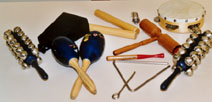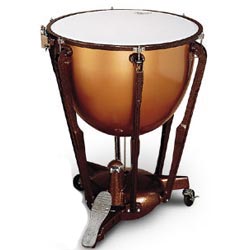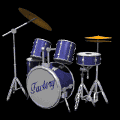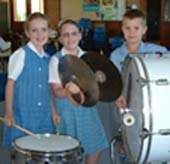|
The Percussion Section is perhaps the most varied and interesting section of the Concert Band or Orchestra.
The Percussion Section consists of many different instruments including:

The Snare Drum.
This is one of the first instruments the students learn. We cover the basic rudiments, stick control and encourage the students to develop their technique.

The Bass Drum.
Although this is a picture of 'kick drum' meaning that it is played with a foot pedal we normally use a bass drum on a stand that is played by hitting the surface of the drum with a mallet.
The bass drum helps keep the basic beat to help the band play in time.

Glockenspiel
Another very important instrument of the percussion family is the Glockenspiel. Students are expected to purchase a 'Glock' with a carry case. The glock is what we call 'tuned' percussion. This means that students learn to read the music not just the rhythm as they do with drums.
This forms the foundation for playing instruments such as the Xylophone, Vibraphone, Marimba and other keyboard percussion instruments as well as giving students an understanding of the piano whose keyboard is laid out in the same way.
| This is a Xylophone |

|
| Students also learn a variety of other instruments |

|
Other instruments that the students get to play are the tambourine, maracas (shakers) clap sticks, wood blocks, crash cymbals, tubular bells, siren whistle, wind chimes and the list goes on.

At schools that have highly devloped percussion sections the students will also get to play the timpani.
Although quite expensive for schools to buy, many schools do own a set of timpani drums as they are considered to be a very important element of the percussion section and can be used to add very dramatic effects.

The Drum Kit!
Just about all percussion students aspire to being allowing on the 'kit'. It is not just a matter of bashing and smashing at the drums - it really is an art to play drum kit well and takes learning the correct technique.

The Percussionist needs to have a very good sense of rhythm and be very versatile. They must develop good team skills as it is essential to work as a team.
The Percussion section is an integral part of the Concert Band and therefore the Percussionist must be very committed not only to practice but also to rehearsals and performances.
What is a Band without a Drummer?
What Equipment Will We Need?
Percussion is an economical choice for those on a tight budget. The student can be set up with brand new instruments for around $300 or less for second hand instruments.To start off with the bare essentials is even much cheaper again.
-
Stantard of Excellence Book 1 for Percussion
-
Accompanying CD's also recommended. Part A is all that is necessary to begin with.
-
A snare drum and stand with carry case, or if on a tight budget a practice pad only. I recommend a Remo tunable practice pad for around AU$50.00. This provides the student with a more realistic drum feel. (A practice pad is also called a Parent Saver - they are much quieter than the snare drum!)
-
A set of drum sticks for around $15-20 AU.
-
A Glockenspiel, carry case and mallets. (like in the picture above)
-
A Music Stand
As you can see this is a much cheaper choice than many of the other instruments.
All the other instruments in the percussion section are usually provided by the Band.
| 
